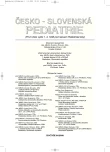SMARCAL1 mutations: A cause of prepubertal idiopathic steroid-resistant nephrotic syndrome
Vyšlo v časopise:
Čes-slov Pediat 2009; 64 (2): 82.
Zivičnjak M, Franke D, Zenker M, Hoyer J, Lücke T, Pape L, Ehrich JH.
SMARCAL1 mutations: A cause of prepubertal idiopathic steroid-resistant nephrotic syndrome
Department of Pediatric Kidney [M. Z., D. F., T. L., L. P., J. H. H. E.], Hannover Medical School, D-30623 Hannover, Germany; Institute of Human Genetics [M. Z., J. H.], Friedrich-Alexander University Erlangen-Nuremberg, D-91054 Erlangen, Germany
Schimke immuno-osseous dysplasia (SIOD) is a rare autosomal-recessive multisystem disorder with disproportionate growth failure, impaired T-cell function, and steroid-resistant nephrotic syndrome. Recently, we presented the typical anthropometric features of SIOD. We now present data on two siblings who were initially classified as suffering from familial steroid-resistant nephrotic syndrome of unknown genetic origin. Apart from growth failure, no syndrome-specific symptoms were found until the age of 10 years. However, serial anthropometric examinations showed the development of a SIOD-like pattern with a decreased ratio of trunk to leg length in early adolescence. The growth pattern was significantly different from that seen in children with chronic renal failure of other origins. Initially the siblings had proportionate short stature but developed disproportion only during adolescence. Molecular genetic analysis revealed compound heterozygosity for a known and a new mutation in the SMARCAL1 gene.
Conclusion: The disease spectrum associated with SMARCAL1 mutations includes previously undescribed milder phenotypes that may be clinically overlooked, particularly before puberty. Serial anthropometric assessment can eventually identify patients with a growth pattern similar to that of SIOD. These patients should be tested for SMARCAL1 mutations to avoid overtreatment with immunosuppressive agents.
(Pediatr. Res. 2008; Dec 24. Epub ahead of print.)
Štítky
Neonatologie Pediatrie Praktické lékařství pro děti a dorostČlánek vyšel v časopise
Česko-slovenská pediatrie

2009 Číslo 2
- Horní limit denní dávky vitaminu D: Jaké množství je ještě bezpečné?
- Isoprinosin je bezpečný a účinný v léčbě pacientů s akutní respirační virovou infekcí
- Syndrom Noonanové: etiologie, diagnostika a terapie
Nejčtenější v tomto čísle
- Očkování proti tuberkulóze
- Geneticky podmíněné formy nefrotického syndromu u dětí
- Refluxní striktury jícnu u dětí – léčba a výsledky
- Monogenní hypertenze
